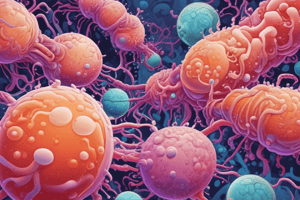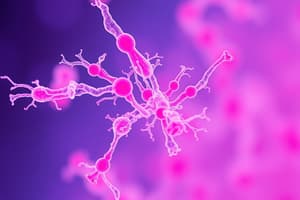Podcast
Questions and Answers
What is the principle of the Bacitracin Test?
What is the principle of the Bacitracin Test?
determine the effect of a small amount of bacitracin (0.04U) on an organism
What is the result of the Bacitracin Test when there is a presence of a zone of inhibition around the disk?
What is the result of the Bacitracin Test when there is a presence of a zone of inhibition around the disk?
- (c) Acid with gas production
- (b) No change in color; no acid production
- (d) No acid production (correct)
- (a) Yellow medium; acid production
What is the function of Staphylocoagulase?
What is the function of Staphylocoagulase?
Responsible for a positive tube coagulase test result. Also present in various Staphylococcus species.
In the Oxidation-Fermentation (O/F) Reactions, glucose is converted to Pyruvic Acid and then to $CO2$ through ________.
In the Oxidation-Fermentation (O/F) Reactions, glucose is converted to Pyruvic Acid and then to $CO2$ through ________.
Staphylococci produce mixed acids such as lactic acid, propionic acid, and succinic acid.
Staphylococci produce mixed acids such as lactic acid, propionic acid, and succinic acid.
Which toxin acts on sphingomyelin in the plasma membrane of erythrocytes?
Which toxin acts on sphingomyelin in the plasma membrane of erythrocytes?
Enterotoxins A, B, and D are heat-stable causes of staphylococcal food poisoning. (True/False)
Enterotoxins A, B, and D are heat-stable causes of staphylococcal food poisoning. (True/False)
Match the enzyme types with their specific tests:
Match the enzyme types with their specific tests:
__________ permits bacteria to spread through connective tissues.
__________ permits bacteria to spread through connective tissues.
What is the Voges-Proskauer (VP) Test used to determine?
What is the Voges-Proskauer (VP) Test used to determine?
Match the enzyme with its function:
Match the enzyme with its function:
What is the color of colonies associated with Staphylococci?
What is the color of colonies associated with Staphylococci?
What does the term 'Staphle' mean in the context of Staphylococci?
What does the term 'Staphle' mean in the context of Staphylococci?
Staphylococci are obligate anaerobes.
Staphylococci are obligate anaerobes.
Fastidious strains of Staphylococci have requirements for CO2 hemin or menadione with at least 48 hrs of incubation. Hemin is also known as Factor ________.
Fastidious strains of Staphylococci have requirements for CO2 hemin or menadione with at least 48 hrs of incubation. Hemin is also known as Factor ________.
Which pathogen causes Mild inflammation of a hair follicle or oil gland?
Which pathogen causes Mild inflammation of a hair follicle or oil gland?
Match the following Staphylococcus infections with their associated diseases:
Match the following Staphylococcus infections with their associated diseases:
Flashcards are hidden until you start studying
Study Notes
Characteristics of Staphylococci
- Staphylococci belong to the family Staphylococcaceae
- They are catalase positive (+) and coagulase positive (+) or negative (-)
- They are gram positive (+) cocci that exist singly, in pairs, and in clusters
- They resemble the family Micrococcaceae and genus Micrococcus
- Micrococci are catalase positive (+), coagulase negative (-), and exist in pairs, tetrads, and irregular clusters
Differentiation between Staphylococci and Micrococci
- Modified oxidase (Microdase) test: Staphylococci are negative (-), Micrococci are positive (+)
- Anaerobic acid production from glucose: Staphylococci are positive (+), Micrococci are negative (-) except for M. kristinae and M. varians
- Anaerobic acid production from glycerol in the presence of erythromycin: Staphylococci are positive (+), Micrococci are negative (-)
- Growth on Furoxone-Tween 80-oil red agar: Staphylococci are negative (-), Micrococci are positive (+)
- Resistance to bacitracin (0.04 U): Staphylococci are resistant (R), Micrococci are sensitive (S)
- Resistance to lysostaphin (200 ug/mL): Staphylococci are sensitive (S), Micrococci are resistant (R)
Staphylococci Pathology
- Staphylococci can cause cutaneous infections such as folliculitis, furuncles, and carbuncles
- They can also cause food poisoning, scalded skin syndrome, toxic shock syndrome, and toxic epidermal necrolysis
- S. aureus can cause bullous impetigo, which differs from streptococcal nonbullous impetigo in that staphylococcal pustules are large and surrounded by a small zone of erythema
- Other staphylococcal species can cause nosocomial infections, wound infections, septicemia, UTIs, and native valve infections
Virulence Factors of Staphylococcus aureus
- Enterotoxins (Groups A-E and G-J) cause staphylococcal food poisoning
- Toxic shock syndrome toxin-1 (TSST-1) causes toxic shock syndrome
- Exfoliative toxins (A and B) cause scalded skin syndrome and bullous impetigo
- Cytolytic toxins (α, β, γ, and δ hemolysins) affect red blood cells and leukocytes
- Protein A binds to the Fc portion of immunoglobulin G (IgG) and blocks phagocytosis
- Enzymes such as coagulase, protease, hyaluronidase, and lipase aid in bacterial spread and infection
Laboratory Diagnosis of Staphylococci
- Culture media used include SBA, MSA, CAN, PEA, and CHROMagar Staph aureus
- Incubation at 35-37°C for 18-24 hours
- Macroscopic examination reveals colonies that are round, smooth, white, and creamy for S. aureus, and small-to-medium-sized, nonhemolytic, gray-to-white colonies for S. epidermidis
- Microscopic examination reveals gram-positive (+) cocci in singly, in pairs, and in clusters
- Mannitol salt agar (MSA) is selective for S. aureus, which ferments mannitol and forms colonies surrounded by a yellow halo### Staphylococci Characteristics
- Produce hemolytic zones around colonies on Sheep's Blood Agar (SBA)
- Gram-positive cocci, often in clusters, with polymorphonuclear cells
- Catalase test: positive, with bubble formation, indicating breakdown of hydrogen peroxide into oxygen and water
Microdase Test (Modified Oxidase Test)
- Principle: oxidase enzyme reacts with oxidase reagent and cytochrome C to form indophenol, a colored compound
- Result: positive, with blue to purple-blue color, indicating micrococci and staphylococci
Biochemical Tests
- Bacitracin Test: determines effect of bacitracin on an organism, with positive result indicating presence of zone of inhibition around the disk
- Oxidation-Fermentation (O/F) Reactions: determines whether an organism uses carbohydrate substrates to produce acid byproducts, with positive result indicating acid production
- Coagulase Test: differentiates Staphylococcus aureus from CoNS by detecting enzyme coagulase, with positive result indicating fibrin clot formation
Coagulase Enzyme
- 2 forms: bound coagulase (clumping factor) and free coagulase (staphylocoagulase)
- Bound coagulase: reacts directly with fibrinogen in plasma, resulting in fibrin clot formation
- Free coagulase: extracellular protein enzyme, reacts with coagulase-reacting factor (CRF) to form coagulase-CRF complex, resulting in fibrin clot formation
Pyrrolidonyl Arylamidase (PYR) Test
- Principle: differentiates S.aureus from other CoNS by presence of enzyme L-pyrroglutamylaminopeptidase
- Result: positive, with bright red color, indicating S.lugdunensis, S.intermedius, and S.schleiferi
Methicillin-Resistant Staphylococcus aureus (MRSA)
- Penicillin-resistant (β-lactam) strains of S.aureus due to presence of mecA gene
- Requires penicillinase-resistant penicillins, such as nafcillin, oxacillin, or cefoxitin
- Types: CA-MRSA, HA-MRSA, MRSA, MRSE
Vancomycin-Resistant Staphylococcus aureus (VRSA)
- VRSA: vancomycin-resistant S.aureus
- VISA: vancomycin-intermediate S.aureus
- TOC: Vancomycin
Macrolide Resistance
- Resistance to clindamycin
- Modified double disk diffusion test (D-zone test)
Studying That Suits You
Use AI to generate personalized quizzes and flashcards to suit your learning preferences.



